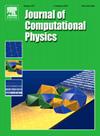Characterization of the forcing and sub-filter scale terms in the volume-filtering immersed boundary method
IF 3.8
2区 物理与天体物理
Q2 COMPUTER SCIENCE, INTERDISCIPLINARY APPLICATIONS
引用次数: 0
Abstract
We present a characterization of the forcing and sub-filter scale terms produced in the volume-filtering immersed boundary (VF-IB) method by Dave et al. [5]. The process of volume-filtering produces bodyforces in the form of surface integrals to describe the boundary conditions at the interface. Furthermore, the approach also produces unclosed terms called . The level of contribution from on the numerical solution depends on the filter width . In order to understand these terms better we take a 2 dimensional, varying coefficient hyperbolic equation shown by Brady and Livescu [3]. This case is chosen for two reasons. First, the case involves 2 distinct regions separated by an interface, making it an ideal case for the VF-IB method. Second, an existing analytical solution allows us to properly investigate the contribution from for varying . The filter width controls how well resolved the interface is. The smaller the filter width, the more resolved the interface will be. A thorough numerical analysis of the method is presented, as well as the effect of on the numerical solution. In order to perform a direct comparison, the numerical solution is compared to the filtered analytical solution. Through this we highlight three important points. First, we present a methodical approach to volume filtering a hyperbolic PDE. Second, we show that the VF-IB method exhibits second order convergence with respect to decreasing (i.e. making the interface sharper). Finally, we show that scales with . Large filter widths would require a modeling approach to sufficiently resolve . However for finer filter widths that have a sufficiently sharp interface, can be ignored without any significant reduction in the accuracy of solution. We show that through the inclusion of these unclosed terms, the VF-IB method can bridge the gap between fully modeled and fully resolved methods by providing accurate results when the filter width is of the same order as the characteristic solid corrugation length scale.
求助全文
约1分钟内获得全文
求助全文
来源期刊

Journal of Computational Physics
物理-计算机:跨学科应用
CiteScore
7.60
自引率
14.60%
发文量
763
审稿时长
5.8 months
期刊介绍:
Journal of Computational Physics thoroughly treats the computational aspects of physical problems, presenting techniques for the numerical solution of mathematical equations arising in all areas of physics. The journal seeks to emphasize methods that cross disciplinary boundaries.
The Journal of Computational Physics also publishes short notes of 4 pages or less (including figures, tables, and references but excluding title pages). Letters to the Editor commenting on articles already published in this Journal will also be considered. Neither notes nor letters should have an abstract.
 求助内容:
求助内容: 应助结果提醒方式:
应助结果提醒方式:


